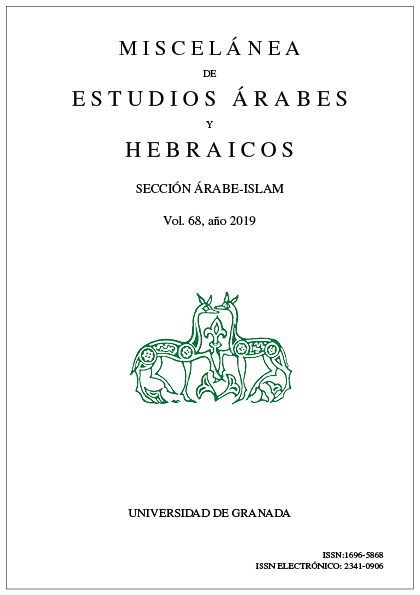La Ka‘ba, el paraíso e Ibn al-Jaṭīb en Šālla (Rabat): el ‘trabajo’ del complejo funerario meriní del siglo XIV
DOI:
https://doi.org/10.30827/meaharabe.v68i0.1000Palabras clave:
Benimerínes, Šālla, Ibn al-Jaṭīb, Arquitectura funeraria, HermenéuticaResumen
A mediados del siglo XIV, el cementerio inicialmente modesto de la dinastía benimerín (668/1269-870/1465) en Šālla se convirtió en un complejo funerario de varios edificios, cuyo ‘trabajo’ principal era atraer e impresionar a las masas de visitantes. Uno de ellos fue Lisān al-Dīn ibn al-Jaṭīb, quien, como se demostrará, vivió principalmente en el panteón real entre 761/1360 y 763/1362. Después de una reconsideración sobre su estancia en el lugar y basándonos esencialmente en sus relatos, el presente artículo se centra en dos preguntas hermenéuticas entrelazadas sobre cómo la experiencia de visitar a Šālla se reflejaba en la percepción de los visitantes. Se demuestra, en primer lugar, que algunas personas interpretaron este jardín del siglo XIV en Šālla como una representación del paraíso. En segundo lugar, después de una breve discusión de cómo el santuario benimerín se con- virtió en un centro de peregrinación, se llega a la conclusión de que algunas de las fuentes coetáneas interpretan a Šālla como un sitio análogo a la Ka‘ba, y que algunos de sus visitantes cumplían ritos adoptados de la peregrinación a la Meca. El objetivo de este artículo es investigar algunas de las formas en que Šālla ‘trabajó’ para glorificar a los miembros de la dinastía benimerín.
Descargas
Descargas
Publicado
Cómo citar
Número
Sección
Licencia
Los autores que publican en esta revista están de acuerdo con los siguientes términos:
1. Los autores conservan los derechos de autor y garantizan a la revista el derecho de ser la primera publicación del trabajo al igual que licenciado bajo una Creative Commons Attribution License que permite a otros compartir el trabajo con un reconocimiento de la autoría del trabajo y la publicación inicial en esta revista.
2. Los autores pueden establecer por separado acuerdos adicionales para la distribución no exclusiva de la versión de la obra publicada en la revista (por ejemplo, situarlo en un repositorio institucional o publicarlo en un libro), con un reconocimiento de su publicación inicial en esta revista.
3. Se permite y se anima a los autores a difundir electrónicamente (por ejemplo, en repositorios institucionales o en su propio sitio web) la versión publicada de sus trabajos (versión post-print del editor) o, en su defecto, el de la versión post-print del autor ya evaluada y aceptada. Esto puede dar lugar a intercambios productivos, así como a una citación más temprana y mayor de los trabajos publicados (Véase The Effect of Open Access).
4. La revista no se hace responsable de las opiniones vertidas por los autores.















